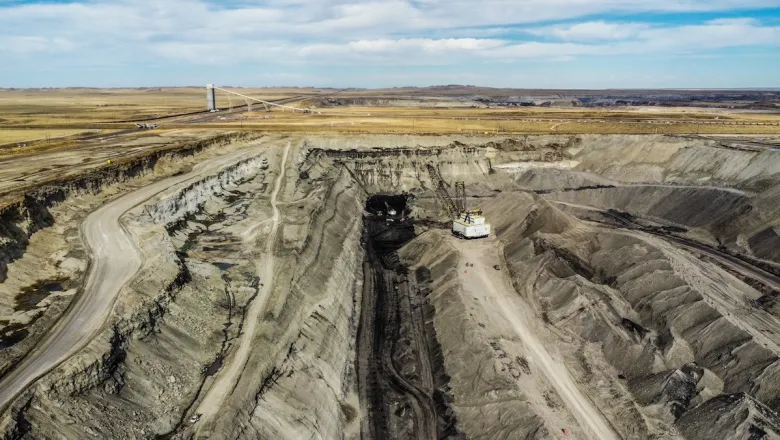Arch Resources Inc. disclosed this week that it’s considering “strategic alternatives” with its thermal coal assets, including the “potential divestiture” of its properties in northeastern Wyoming’s Powder River Basin and elsewhere. Arch President and CEO Paul Lang said on a telephone call with Wall Street analysts that his company’s internal view is that PRB coal production could drop about 5% to 10% annually. That includes Arch’s Coal Creek and Black Thunder mines.
“I think there is a diminishing role in the U.S. for coal,” Lang said.
.png)
An aerial view of Black Thunder Coal mine in northeast Wyoming. It’s owned by Arch Resources Inc.
Market consolidation in the coal world is not new, and seems difficult to make stick.
No Joint Venture, No PRB Future For Arch
In September 2020, Arch and Peabody Energy Corp. abandoned a joint venture after the two businesses couldn’t convince federal regulators that the combination wouldn’t reduce competition. Under the joint venture, Peabody would have become the managing company of their combined coal mining operations in Wyoming and Colorado. That included a plan to merge the Black Thunder and North Antelope Rochelle mines, which separately already the top two producing thermal coal mines in the U.S. And in November 2022, Australian-based Global Resources called off negotiations in a potential $9 billion-plus merger with Peabody.
The St. Louis-based Arch also disclosed in filings with the U.S. Securities and Exchange Commission this week that its West Elk mine in Colorado is picking up the slack for weaker shipments out of its Powder River Basin mines. John Drexler, senior vice president and chief operating officer with Arch, said on the call with analysts Thursday that the company is guiding to 50-56 million tons of coal production in 2024 in the Powder River Basin, a weak forecast compared to what was mined last year.
In 2023, Arch’s Coal Creek mine produced 2.3 million tons of coal, down 39% from 3.8 million tons in 2022. Black Thunder mine in the Powder River Basin — one of the largest coal mines in the United States — showed a 2.6% drop in production last year, going from 60.6 million tons of coal produced in 2023 versus 62.2 million tons in 2022. But that pales compared to the mine’s historic production. In 2014, Black Thunder produced 101 million tons of coal, which makes last year’s tally a 40% drop over the last decade.
“The thermal outlook is weak with sales guidance below committed volumes levels,” observed Lucas Pipes, an analyst with B Riley Securities.
Accelerating Reclamation
The diminishing role of coal sales from Wyoming comes amid the backdrop of federal clean air policies shifting to alternative forms of power generation from wind and solar sources — all at the expense of carbon-based fuels like coal, oil and gas. Electric utilities also are showing less appetite for coal as they change out their fuel-burning equipment to take natural gas.
In an annual filing made with the SEC on Friday, Arch stated that its West Elk mine has “acted to counterbalance lower shipment levels stemming from a weakening demand environment” for coal supplied from the Powder River Basin. In yet another possible indicator of future plans, Arch stated in a quarterly SEC filing made Thursday that it had completed $15.9 million in reclamation contributions to its Powder River Basin operations as it continued to “shrink its operating footprint.” Arch’s mine reclamation fund is topped out at $142.3 million and won’t need further contributions, the company stated.
The reclamation costs are significant since Arch unveiled plans to shut down its Coal Creek mine in northeastern Wyoming nearly three years ago as the volume of coal scraped from the surface pit operation has tapered off. About a year ago, Campbell County commissioners and other local economic development officials began working in earnest with Arch to cushion the blow of closing the mine about 30 miles southeast of Gillette near Wright.
That’s when the idea of turning the site into an industrial park came to mind. After all, the inevitable was coming and local officials couldn’t just sit on their hands facing a grim outlook of the closure of Coal Creek and the eventual closure of Arch’s flagship Black Thunder mine just south of it.
Continues To Mine Money
While Arch hasn’t said what it’s firm timeline is for shuttering its Wyoming mines — or selling them, if they can — it has repeatedly maintained a corporate stance that it wants to be out of the thermal coal business. In the Friday filing, Arch said the PBR mines can continue to provide “significant, incremental cash flow” while “self-funding their own closure obligations over the longer term.”
Arch announced in 2020 its plans to shut down Coal Creek and Black Thunder, and while the company continues to mine Black Thunder for the cash flow it can create, it’s tapered off Coal Creek significantly. At the same time, Arch has reported it’s accelerated its reclamation of both mine sites. The demise of Coal Creek began in earnest in 2019, when it dropped to 2.5 million tons of production compared to the 8 million tons the year before. In the years since, the mine has continued to produce in the low 2 million tons range, except for 2022, when it pulled 3.8 million tons out.
On Thursday, Arch reported 2023 fourth quarter profit of $114.9 million on revenue of $774 million versus year-earlier profit for the same period of $470.5 million on revenue of $859.5 million. For 2023, Arch reported profit of $464 million on revenue of $3.1 billion versus year earlier profit of $1.3 billion on revenue of $3.7 billion.









